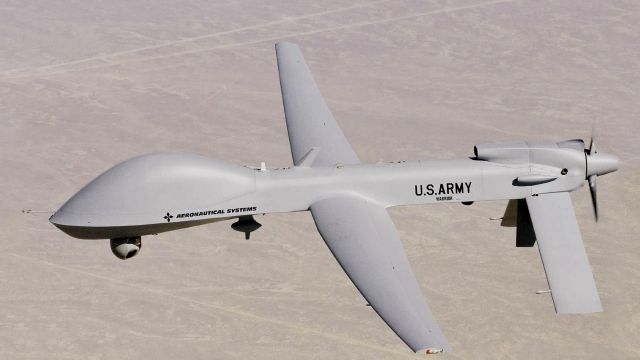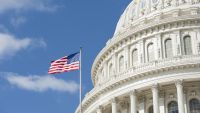A different kind of drone strike
Drone technology is not suitable for use in civilian airspace
By Matthew B. Keelen, Bud DeFlaviis
In the past decade, much has been said about the use of drone technology, particularly its use in combat. More recently, the filibuster by Sen. Rand Paul, R-Ky., questioned privacy and other concerns as this technology is deployed domestically.
As with many breakthrough technologies developed for and by the military, drones are now being repurposed for peaceful purposes.
Drones, also known as unmanned aerial vehicles, have proved effective in achieving military objectives while keeping our war-fighters safe. They also capture the collective imagination and possess a “gee-whiz” factor that stokes curiosity and a new era of possibilities.
Last year, President Barack Obama signed into law the Federal Aviation Administration Modernization and Reform Act, which, among other things, set the stage for greater drone proliferation.
From the time the law was enacted, the FAA has received a number of petitions from public entities seeking to start their own unmanned aerial vehicle programs, primarily for law enforcement purposes. The agency also began the selection process to set up six separate test sites across the country.
The private sector is not far behind. Entrepreneurial minds are devising plans to use drones to help farmers mind crops, landlords spot intruders and doctors deliver lifesaving medications.
Our firm represents two airline pilot unions whose employees are responsible for the safe transport of nearly 300,000 passengers every day. These professionals, many of whom are former military pilots, are no Luddites — they embrace technological change so long as it is adequately tested and proved effective.
At this point, drone technology is not suitable for use in civilian airspace as it fails to meet modern safety standards. Pilots and other air safety advocates have petitioned the FAA to use the same methodical, time-tested approach to developing comprehensive safety standards before drones operate within U.S. airspace.
Some industry officials will undoubtedly argue for a fast-track approach; however, there is too much to consider, and too many things that can go wrong with the technology as it exists.
Despite their effectiveness, drones are still accident-prone. A report from the National Business Aviation Association found that the most advanced drone aircraft suffer from an accident rate 100 times higher than modern airliners.
Regulators, industry officials and the public should be concerned about midair accidents, which are rare but not unthinkable. The pilots we represent train extensively to avoid these incidents. However, a 2011 accident involving a cargo plane and a drone in Afghanistan demonstrates that the potential for collisions remains.
Operational performance and potential for collision are items that the Government Accountability Office cited in a report recently sent to Congress. The GAO also noted vulnerability to electronic sabotage — citing the case of a University of Texas professor who hacked into and took control of a Homeland Security aircraft midflight.
Pilots consider safety their No. 1 priority, but they are also concerned about the effect that unmanned technology will have on the profession.
Over the years, the number of professionals needed in the cockpit to safely transport people and cargo has diminished, but the demand for qualified personnel has not.
Aircraft manufacturers and airlines may be tempted to replace one or both pilots with remote flying systems — a prospect that makes it possible for a pilot to be thousands of miles away from a flight he or she is commanding.
The problem with this is twofold. First, emergencies like the “miracle on the Hudson” may not have such a storybook ending. In that case, Capt. Chesley Sullenberger, a seasoned pilot, was able to take immediate steps to save hundreds of lives during that ill-fated takeoff.
Second, diminishing the human element could make flights seem too routine, slowly erode many of the basic skills each pilot must have and create an over-reliance on technology ill-suited for certain emergency situations.
The past can serve as a guide to help us understand how hasty aviation decisions should be handled. In the days following World War I, the U.S. government sold thousands of surplus “Jenny” biplanes to civilians. This move helped create the “barnstorming era,” a rapid development of civil aviation which was sadly fraught with deadly accidents.
Pilots have a deep passion for flying, and they welcome innovation that improves the flying experience. But they know that new technologies must be proved before they are fully embraced.
History has a nasty habit of repeating itself. We should not risk lives in our eagerness to push the boundaries of aviation. But lessons learned can serve as a guide for moving forward.
In the early 2000s, airline passengers who were tired of being mistreated during lengthy takeoff and landing delays lobbied for better treatment. After several attempts, Congress codified an airline passenger bill of rights.
Rest assured that pilot groups and other safety advocates will continue to work with lawmakers and regulators to ensure flights by unmanned aircraft will never interfere with commercial flights; however, if we want Congress to act quickly and in a meaningful way, everyday fliers would be well-served in raising the issue now.
About the Authors
Matthew B. Keelen, founder and President of the government affairs firm The Keelen Group, is a widely known and highly regarded lobbyist and political strategist with experience building relationships with key figures and a reputation for consistently delivering hard-earned victories. Acknowledged for his innate ability to establish and develop long lasting political relationships, Keelen has dozens of time-tested relationships with Members of Congress, including many who are in positions of considerable influence today. To learn more about The Keelen Group, visit www.keelengroup.com.
Bud DeFlaviis joined the Keelen Group LLC in May of 2012 after serving for two years as the Executive Director for the Sustainable Buildings Industry Council.



















